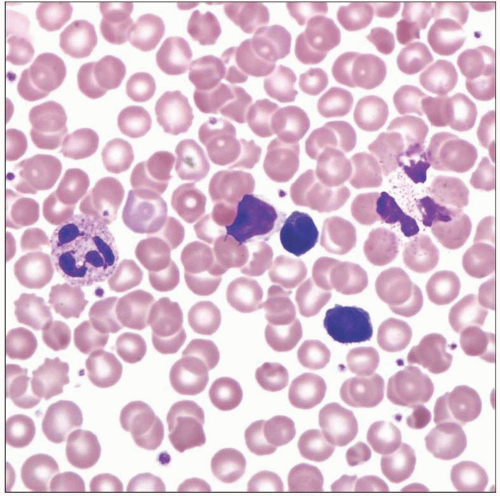Lymphopenia, Constitutional and Acquired
Qian-Yun Zhang, MD, PhD
Key Facts
Terminology
Lymphopenia is defined as absolute lymphocyte count < 1,000/µL in adults or < 2,000/µL in children
Etiology/Pathogenesis
SCID is immunodeficiency with defects in both humoral and cell-mediated immunity
DiGeorge syndrome results from malformation of 3rd and 4th pharyngeal pouches
ICL has unknown etiology; may represent various disorders and is likely multifactorial
HIV/AIDS infections cause lymphopenia by several mechanisms
Autoimmune disorders are linked to lymphopenia as a consequence of self-destruction
Chemotherapy causes destruction of lymphocytes
Clinical Issues
HIV infection is most common cause of lymphopenia
SCID is associated with excessive number of severe infections since infancy
DGS is associated with T-cell immunodeficiency
Clinical presentation of ICL patients can range from asymptomatic to life-threatening infections mimicking AIDS
Bone marrow transplantation cures SCID
Thymus transplantation in patient with complete DiGeorge anomaly corrects severe immunodeficiency
Antiretroviral drugs, such as reverse transcriptase inhibitors, protease inhibitors, CCR5 inhibitors, and fusion inhibitors, target various stages of life-cycle and result in lifelong viral suppression
TERMINOLOGY
Synonyms
Lymphocytopenia
Definitions
Absolute lymphocyte count < 1,000/µL in adults or < 2,000/µL in children
ETIOLOGY/PATHOGENESIS
Congenital Immunodeficiency Disorders
Severe combined immunodeficiency disease (SCID)
Immunodeficiency with defects in both humoral and cell-mediated immunity
Pathogenesis
Impaired precursor survival due to mutations in adenylate kinase 2 gene or deficiency of adenosine deaminase
Defects in cytokine-mediated signaling due to mutations in IL-2 receptor gamma gene or IL-7 receptor gene
Deficiency of the common gamma chain of T-cell growth factor receptor and other growth factor receptors
Defect in immune recognition receptors on T- and B-cells due to mutations in RAG1, RAG2 genes
Defects in CD3 development due to mutations CD3 complex genes
Defects in T-cell development/signaling due to ZAP70 or STAT5B gene mutations, or major histocompatibility complex (MHC) class II deficiency
DiGeorge syndrome (DGS)
Results from deletion of chromosome 22q11.2
Transcription factor gene TBX1 may be responsible at molecular level
Malformation of 3rd and 4th pharyngeal pouches, which give rise to thymus, parathyroid glands, part of aortic arch and face
22q11.2 deletion may also give rise to velocardiofacial syndrome, with congenital heart diseases as major manifestations
Idiopathic CD4 T-lymphocytopenia (ICL)
Unknown etiology; may represent various disorders and is likely multifactorial
Diminished generation of T-cell precursors
Increased T-cell apoptosis
Failure of T-cell development
Defective cytokine production
CD4 autoantibody
Acquired Immunodeficiency Disorders
HIV infection/AIDS causes lymphopenia by several mechanisms
Transmitted through sexual or parental exposure to HIV-containing fluids or maternal-fetal transmission
HIV viruses cause destruction of CD4(+) lymphocytes
HIV-mediated destruction of mucosal barriers
Damage of thymus and other lymphoid tissues
Other viral infections
Bacterial infections
Systemic disorders linked to lymphopenia via diverse mechanisms
Nutritional deficiencies
Protein-losing disease; GI or renal diseases, burns
Malignancy
Autoimmune disorders are linked to lymphopenia as consequence of self-destruction
Therapy causes lymphocyte destruction
Radiation/chemotherapy
Antilymphocyte globulin
CLINICAL ISSUES
Epidemiology
Incidence
SCID is rare; X-linked or autosomal recessive inheritance
DGS affects 1 in 2,000-4,000 live births
Idiopathic CD4 lymphocytopenia (ICL) is rare; can be seen in any age
HIV infection is most common cause of sustained lymphopenia
Stay updated, free articles. Join our Telegram channel

Full access? Get Clinical Tree




